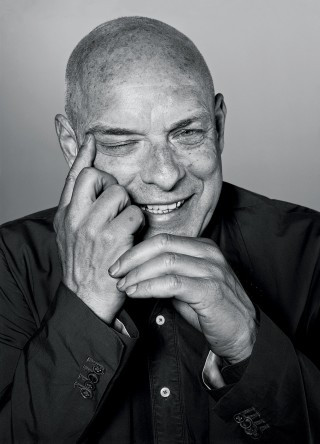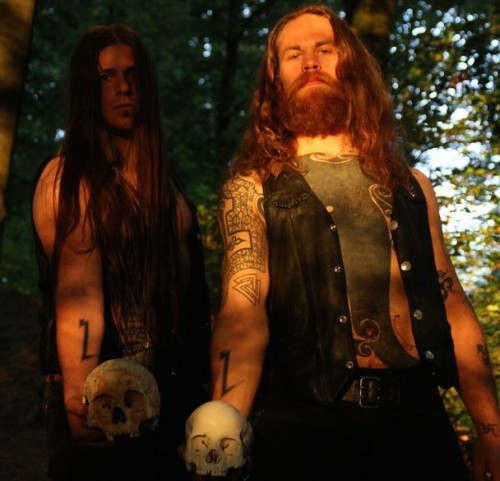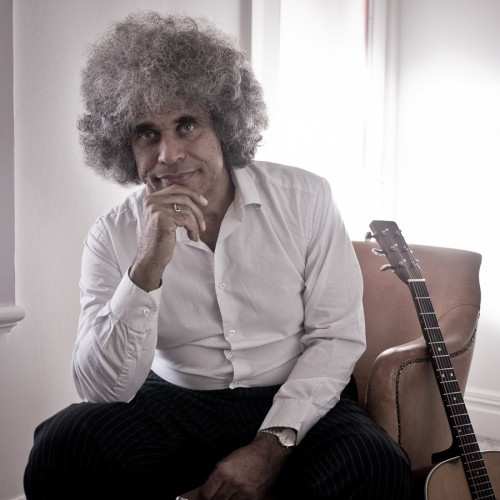Eno (photo by Richard Burbridge)
Yesterday I read two articles that jarred a few thoughts loose in my head. One was a feature () by Sasha Frere-Jones in The New Yorker about the musician Brian Eno and one was a Q&A (here) between Kim Kelly and Bölzer’s guitarist/vocalist Okoi “KzR” Jones that appeared at Stereogum.
Eno is credited with coining the phrase “ambient music”. He first became visible through his membership in the band Roxy Music and his subsequent solo albums of pop and rock songs that made extensive use of synthesizers. He produced Devo’s debut album, produced and performed on three albums by Talking Heads, produced seven albums for U2, wrote music and performed on three David Bowie albums, collaborated with King Crimson’s Robert Fripp on multiple records, and worked as a producer and/or performer with many other musicians too numerous to mention. On top of that he is a visual artist, and he has continued experimenting in the creation of music to the present day.
When he spoke to Sascha Frere-Jones in 2013, Eno said:
“I think negative ambition is a big part of what motivates artists. It’s the thing you’re pushing against. When I was a kid, my negative ambition was that I didn’t want to get a job.”
Listening to Eno’s music and reading about the evolution of his life as an artist, you get the sense that his “negative ambition” extended beyond not wanting to get a conventional job. As Sasha-Jones wrote of his art, “Eno fights against received wisdom and habit”. Even in his work as a producer, “Eno often works with highly skilled musicians and then asks them to play against their own virtuosity”.
********
Negative ambition undoubtedly drives the creation of metal, too. Not wanting to get a conventional job until there’s no other alternative, that’s part of it. But the underground, counter-cultural mentality of metal feeds the music itself. There’s a drive in the creative process that comes from not wanting to sound like what most people spend their time listening to, pushing hard the other way with loud, abrasive, often disturbing sounds in which melody may play very little role (or in which the minor keys become dominant).
I don’t mean to suggest that metal musicians are always consciously fighting against something else in the creative process. Just being “Not-X” doesn’t provide a very clear path to being something else. You can make a long list of places you don’t want to go, but you still have to find a destination. Plus, metal musicians (like their fans) usually find enjoyment in the music they’re making that’s more than the satisfaction which comes from rebelling against “the received wisdom and habit” of dominant cultural norms.
I also don’t mean to suggest that negative ambition is equally important in the creative process that drives all metal musicians. I would guess that all artists in every field of art begin the journey of their own artistic growth by copying or mimicking the work of others. You may still be pushing against something else when you do that, by mimicking musical styles that are a slap in the face to something else, but you’re also embracing an ideal as a means of learning and growing in your skills.
Some metal musicians never let their negative ambitions push them off the path of mimicry. They don’t grow, they never stop sounding like hundreds of other bands whose styles they copied, they’re content to remain copycats — or they simply lack the ability to be anything else. There’s a bell curve in this field of endeavor like there is in everything else. True visionaries and creative geniuses are small in number, lodged down at the thin end of the curve. Maybe they’re driven even more strongly by negative ambitions than artists in the bulging middle — pushing against even the norms of metal’s tiny musical culture — or maybe they’re just naturally better at channeling their inspirations into the creation of music that’s unusual but still excellent. But the more convention you reject, the more you necessarily drive yourself to make something new.
********
On the strength of comparatively few songs, the Swiss duo named Bölzer have already positioned themselves down at the thin end of the bell curve. Like many death metal bands, their music is harsh and abrasive, but it’s unusually distinctive and idiosyncratic. From the varying tones of the guitars, to the varying styles of the vocals, to the unusual timing of the drumbeats, to the dynamic structuring of the songs, to the otherworldly character of the melodies, Bölzer’s music doesn’t sound quite like anything else — and in short order they’ve found an appreciative audience that’s growing rapidly, mainly by word of mouth. But as their profile has risen, they’ve started to get the kind of attention that goes beyond the music itself.
And so KzR is getting interviewed for “big platform” web sites like Noisey and Stereogum. And he’s being asked about such things as his stylized swastika tattoos. Stereogum’s editors, of course, had to put a reference to the swastika tattoos in the headline of their interview, because nothing sells copy like controversy. And of course the reader comments on the interview were almost entirely about the swastika tattoos despite the fact that the subject occupied only a few paragraphs at the end of a very long and wide-ranging interview that was mainly focused on the music. Welcome to the internet.
KzR was quite clear about the tattoos:
“I don’t want to be misunderstood. My sunwheels, my swastikas, my whatever you call them, it’s an ancient symbol used by basically every culture on this planet at some time or another for more or less the same reason, to express their adoration for the sun, the solar power. Most of them were sun-worshipping peoples, or held respect for the balance of the sun. It’s also a lunar symbol in itself for the sun cultures. Its right or left form reversed is a lunar symbol, too, and it’s a female as well as a male symbol; it represents a lot of different energies. It’s a continuum, it can be a destructive force, it takes a lot of natural philosophies into one. If you read about it, it’s really fascinating.”
 He was then asked about the reason for the band’s use of the wolf’s hook symbol (referred to in Bölzer’s best-known song, “Entranced by the Wolfshook” and incorporated into their logo), which was an ancient runic symbol appropriated by Nazi Germany and used as the insignia for various SS units.
He was then asked about the reason for the band’s use of the wolf’s hook symbol (referred to in Bölzer’s best-known song, “Entranced by the Wolfshook” and incorporated into their logo), which was an ancient runic symbol appropriated by Nazi Germany and used as the insignia for various SS units.
KzR responded as follows:
“Indeed, man’s lusting for power is as a wolf’s for meat … often leading to self destruction. For us the wolf’s hook, or Wolfsangel, is one of the many symbols of antiquity to become caustically stigmatized as a result of their usage within a fascist-era Europe, something we are soberingly aware of but do not condone. Enough systematic cultural lobotomization has taken place in the past to make any such further demonization of values and symbolism acceptable within a modern and supposedly tolerant society. We promote the growth and enlightenment of the individual, the last thing on our agenda would be to glorify the implements of power involved in the collective enslavement of a people and their individualism. Fascism and racism in that sense are pretty unattractive for us.”
If one needed further proof that KzR meant what he said, consider that his father is Paul Ubana Jones, a musician now living in New Zealand who was born in London to a Yorkshire mother and a Nigerian father (his biography can be found here):
None of this prevented people in the comment section from attacking KzR as a “closeted bigot” and “clueless and arrogant” — which led KzR to join the fray (perhaps unwisely) with comments such as this:
“I am as far away from a politically or racially motivated person as you can get. I am a proud bastard of three different cultures, one of them being african. So if you think I am a crypto-fascist, think again buddy.”
Ah yes, welcome to the internet, where even a modest amount of celebrity means your word is no good and you become fair game for psychoanalysis by people who’ve never met you.
I suppose one might argue that KzR could have expressed the concepts he described in the interview with different symbols for solar power and man’s self-destructive lust than the symbols he actually chose. He undoubtedly was not oblivious to the appropriation of those ancient symbols by a 20th century regime of genocidal monsters. Maybe that was part of the point — if you’re trying to represent the dualism of lightness and dark in human nature (a concept central to Bölzer’s ethos), few things are darker than the horrors perpetrated by the Nazi regime.
Or I suppose one might speculate that this, too, is just one more example of a decision to represent creative passions in a way that pushes against “received wisdom and habit”: negative ambition.




Interesting way to review an album of music.
One wonders though: Could it count as negative ambition if one’s ideas feel normal rather than the actual norm?
Well, that is an interesting question. I would say the answer is no — at least not in the sense I think Eno was talking about, because it’s not a conscious pushing away from or resistance to something else. The result may be adversarial, but the process that leads to it is more natural and spontaneous (if I’m understanding what you mean).
But I’m sure no creative process is as black and white or as easily defined as my post might imply. It’s more a mix of drives and impulses.
Baby’s on Fire!!!!!!!!!!!!!!!!!!!!!!!!!!!!!!!!!!
Yeah!!!!!!!!
What?
Pretty excellent interview with KzR, great read!
That comments section, though…jesus… Every time I find myself reading the comments section on other sites (metal or otherwise), I wonder what the hell I was thinking when I scrolled down past the main article. This time I even knew what was going to happen and I still read on.
It’s at once infuriating and irresistible.
I have to say I never read the comments at other sites. I read the comment section on that interview only because I’d already seen friends talking about it on Facebook, and couldn’t resist.
I’ll admit, knowing beforehand where the comments were going did pique my curiosity a little, but after about ten or so I just had to give up and stop reading.
First time listening to this band, i thought it would be way more “out there”. I liked the songs, but the way everyone’s been describing them led me to believe the music would be mind-numbingly strange. Great sense of melody, cool vocals, but the drums and song structures seem to be a little on the safe side. Anyway, good stuff.
His father is Paul Ubana Jones!? Seriously, I would not have made that link in a million years.
I had no idea about this either until KzR mentioned it in the comment thread accompanying the interview. I’ve read a fair amount of stuff about Bölzer since discovering their first EP and had never seen any mention of it before.
I didn’t know about KzR and I will be reading the interview right now, but I think it’s pretty high time that all the people of the world, especially western world, reclaimed possession of ancient symbols.
I’ve been in India many times and the svastika is everywhere, because it’s THEIR sacred symbol. I even bought tableclothes with svastikas on it. It’s time to go way past the simple equation svastika=nazi. It should become, ok, this is an ancient symbol, it was perverted for a small amount of time (think 20 years) by an elite of madmen (to put it simple), but the symbol had 8000 years of life before and many more ahead. Let’s absolutely be VERY conscious about the misuse made of the symbol, but don’t blame the symbol itself.
Well said. And the interview is very much worth reading in full.
Yeah, it’s pretty good. Unfortunately, I also scrolled down to the comments. -___-
I remember the cover art of their previous EP but for some reason I never listened to it. Now I have to catch up on both (and a shitload of other music…)
So wait, KzR isnt 100% white??? No longer a Bolzer fan!!!!!!!!!!!!!!!!!!!!!!ARHRHGHGHGGGG
I sympathise with KzR’s use of the swastika and appreciate his appropriation of it into his culture. Attempting to assimilate it into our modern concsiousness positively once more is commendable. I think the crux is that it’s not his heritage. Visit India, and it is everywhere. It is their symbol they’ve been using for thousands of years. But it hasn’t been so prevalent in Scandinavian countries. This conflict then evidently undermines his intentions. I place it akin to a non-Arabic person, with no ancestry of that area, nor family, having a tattoo in Arabic. It’s nice, and may mean something to them, however there is a history of thousands of years behind that ancient language. As a relative outsider of that culture then it can easily manufacture misgivings of intentions. A naviety perhaps. The internet has burgeoned a global community and more and more influences from all corners of the world is embracing eachother at different levels of society that may not have penetrated before. This effect is easily overlooked, and sensationalism drives page views. I’d wager a majority of the comment section is 30+ of age. They grew up in a different disconnected society, used to local influences, seeing local trends and habits. Maybe they recognise the swatika’s modern use alongside Punk’s use of it in the 80s tretching into the 90s. People go by what they know, and trust their own experiences more than anything a guy says on the internet. Of course, this is all generalising, and the fun is in the inidividual pursuits, but sometimes you have to paint a broad picture to attempt an understanding.